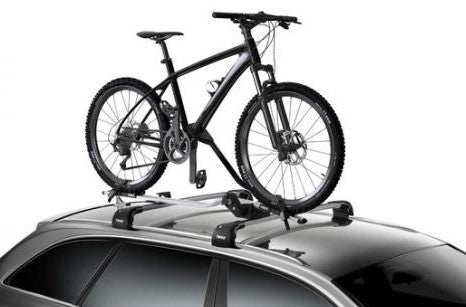What's the right rack for your bike and your vehicle? Here are a few key things to consider...
Here are some key points on the different types of bike racks.
Roof mounted bike racks

-
They use up your roof rack space, so depending on the number of bikes you have you might struggle to get your roof box or surf boards up there too.
- If you have a very tall car, you might struggle to get the bikes on and off the roof if you don't have something to stand on.
- They are generally not suitable for e-bikes as these are often too heavy.
- Also, beware of low parking building roofs, garages and car ports!!!

Pro's
- You can fit multiple bikes on the roof.
- The rear of the car is free, so you can still open the boot or attach a trailer or caravan.
- They hold bikes securely, and most are lockable.
- Your number plate and lights will still be visible.
- Each carrier can typically carry a bike up to 15kg, but you will need to check the roof carrying limit of your vehicle and roof racks.
There are two main options for roof mounted bike racks, both-wheels-on and front-wheel-off.

- These are now a very popular option as it is very quick and easy to load the bikes on and off.
- With the ever-changing size of bike forks you don’t have to worry if your bike will fit as the wheel stays on.
- And there is no need to try and find space for the wheel you have taken off.
- Expect to spend around $300 - $400 per carrier.

- Still very popular with road cyclists.
- Although fork sizes are changing most brands do sell adaptors.
- Generally when using adapters the bikes cannot be locked on.
- Expect to spend around $300 - $400 per carrier
Tow bar / hitch mounted bike racks
Another way to carry your bikes is to use a bike rack that attaches to a tow bar or hitch mount. Tow bar versions mount directly to the tow ball. Removable ‘hitch’ mounted tow bars are becoming more popular and the hitch mount bike racks mount directly into the hitch once the tow ball assembly is removed.

- Mount directly onto the vehicle's tow bar or hitch, leaving the roof free to carry other loads.
- They are very sturdy and secure.
- Many models will tilt or swing out of the way, allowing you to access the boot.
- The bikes can be locked to the rack, and the rack to the car.
- They hold the bike nice and low. So it's easy to lift the bikes onto the rack, meaning they're good for tall cars - or short people!
- The best option for e-bikes.
Con’s
- They use the tow ball, so you can’t tow a boat or trailer at the same time.
- They can obstruct your cars reversing camera, number plate and lights.
- They do stick out behind your car, so you need to be especially careful when backing.
As with roof mounted bike racks there are two main options, those that mount the bike by the frame, and those that mount using the wheels.

Wheel mount
- Ideal for heavier e-bikes and larger mountain bikes.
- 2 and 3 bike options available.
- Larger models have lights and number plates.
- You can spend anywhere from $600 up to $1,500, but worth it if you love your bike!

Frame mount
- Ideal for lighter bikes.
- There are options available to carry up to 5 bikes.
- Can mark the bikes through rubbing.
- You can spend anywhere between $200 and $800 depending on the quality and number of bikes you want to carry.
Rear mounted bike racks

- Rear mounted bike racks are normally the cheapest, so are ideal for occasional use.
- You can carry up to 3 bikes.
- They don't need any extras, like roof racks or a tow bar, which can add to the cost if you don't have them already.
- Expect to spend between $180 and $500.
- Fitting is vehicle specific, so you need to make sure you choose the right one for your vehicle.
- Certain vehicle body types, such as plastic spoilers and split boots, may not be suitable.
- They can't normally be locked - you can pass a lock through the bikes, but the rack can still be removed.
- It may (or may not) be difficult to access the boot or hatch of your car.
Spare wheel mounted bike racks

- No need to fit a tow bar or roof racks to your vehicle.
- The roof is still free for all your other kit.
- They will often swing out of the way if your spare wheel has that option.
- Expect to spend between $300 and $500.
- Getting one to fit your vehicle can often be tricky. So make sure you check it is compatible before you buy.
- They can obstruct your cars reversing camera, number plate and lights.
- They do stick out behind your car, so you need to be especially careful when backing.
Ute tray mounting options

- Racks on tracks – if your ute has tracks of the tray.
- Mounted directly on hard covers or the bed of your ute.
- Over the tail gate.
- That the option you choose is fit for purpose, not just what your mates have.
- Ease of installation of the carrier and frequency of use.
- Ease of installation of the bikes.
- Number of bikes it can hold.
- Safety features such as locks, padding, and guards.
- And remember to carefully check the manufacturers specifications.

